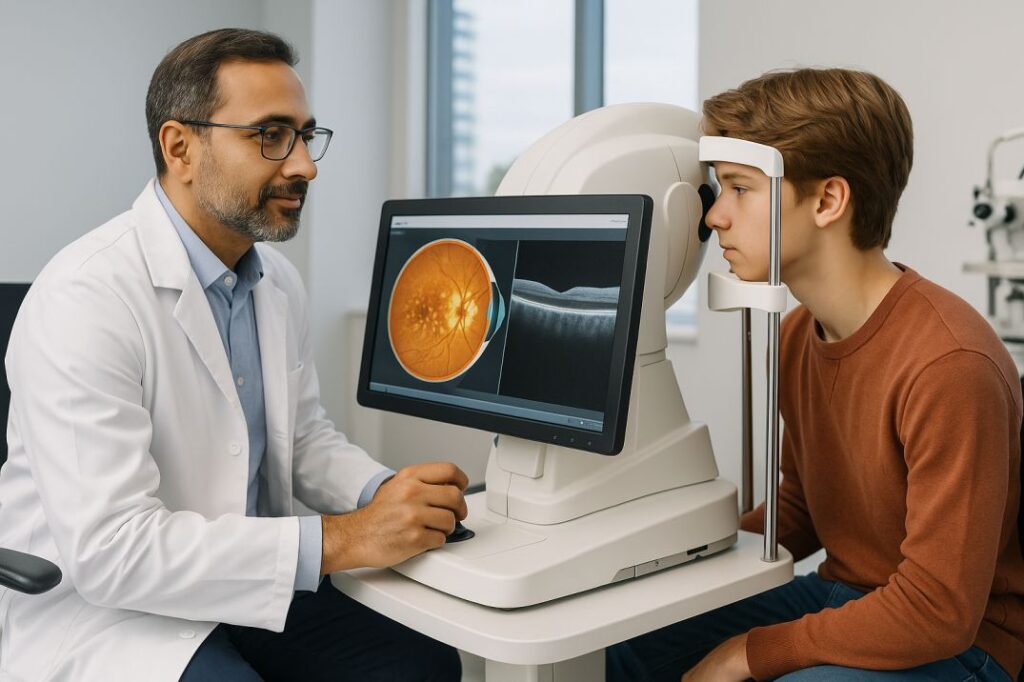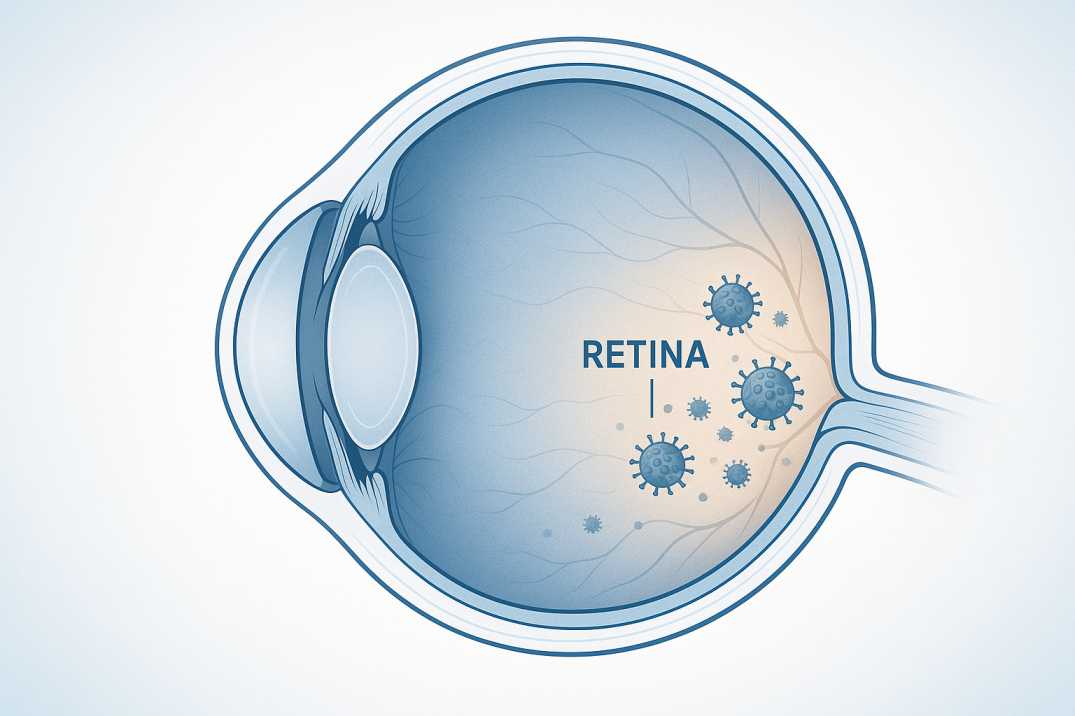Stargardt Disease Treatments 2025 | Cannon EyeCare
Stargardt Disease affects 1 in 8,000-10,000 people worldwide, as the most common inherited juvenile macular degeneration. While no cure exists yet, breakthrough gene therapies in 2025 clinical trials offer new hope. Early diagnosis and expert care from specialists like Cannon EyeCare in Seattle can significantly slow progression and improve quality of life.
What is Stargardt Disease? Understanding the Most Common Juvenile Macular Degeneration
Stargardt Disease, also known as Stargardt macular dystrophy or fundus flavimaculatus, is the most common cause of inherited juvenile macular dystrophy. Named after German ophthalmologist Karl Stargardt, who first described this genetic eye disease in 1909, it primarily affects the macula, the central part of the retina responsible for sharp, detailed vision.
Key Facts About Stargardt Disease:
- Affects 1 in 8,000 to 10,000 people globally
- Accounts for 7% of all retinal degenerations
- Usually appears between the ages of 10-20
- Caused by ABCA4 gene mutations in 95% of cases
- Progressive central vision loss while peripheral vision typically remains
Understanding the Visual Impact
Stargardt Disease causes progressive central vision loss due to the accumulation of toxic byproducts in the retinal pigment epithelium (RPE). Vision loss usually starts in childhood, but some people with Stargardt disease don’t start to lose their vision until they’re adults. The condition primarily affects detailed central vision needed for activities like reading, writing, driving, and recognizing faces, while typically preserving peripheral vision.
Stargardt Disease Symptoms: Early Warning Signs Parents Should Know
Recognizing Early Symptoms in Children and Teens
The initial symptoms of Stargardt Disease can be subtle and develop gradually. Most patients present in childhood or early adolescence, though late-onset cases can occur in adulthood. Early detection is crucial for optimal management and treatment planning.
Primary Early Warning Signs:
- ✓ Progressive central vision loss in both eyes
- ✓ Difficulty reading small print or seeing fine details
- ✓ Blurred or distorted central vision while peripheral vision remains clear
- ✓ Color vision problems distinguishing between similar colors
- ✓ Light sensitivity and difficulty with glare
- ✓ Trouble adapting between bright and dim lighting
- ✓ Central blind spots (scotomas) that gradually expand
Advanced Stargardt Disease Symptoms
As the condition progresses, patients may experience:
- Severe visual acuity reduction uncorrectable with glasses
- Loss of contrast sensitivity makes objects difficult to distinguish
- Night vision difficulties in some cases
- Wavy or distorted vision (metamorphopsia)
- Significant central vision loss while maintaining peripheral sight
Understanding the Genetic Causes
The ABCA4 Gene Connection
Mutations in the adenosine triphosphate binding cassette transporter alpha 4 subunit (ABCA4) gene cause this condition and are inherited in an autosomal recessive pattern. The ABCA4 gene plays a crucial role in the visual cycle by helping transport toxic substances away from photoreceptor cells in the retina.
When the ABCA4 gene is mutated, it leads to:
- Accumulation of toxic byproducts like lipofuscin in the RPE
- Formation of A2E compounds that damage retinal cells
- Progressive photoreceptor cell death, particularly in the macular region
- Characteristic yellowish flecks are visible during eye examinations
Inheritance Patterns
The gene associated with this form of Stargardt disease is called ABCA4 on chromosome 1. Alterations in another gene called ELOVL4 cause a less common dominant form of the disease. Most cases follow an autosomal recessive inheritance pattern, meaning both parents must carry a mutated gene for their child to develop the condition.
Advanced Diagnostic Approaches
Comprehensive Eye Examination
Diagnosing Stargardt Disease requires a thorough evaluation by an experienced eye care professional. An eye care professional can diagnose Stargardt disease by examining the retina. Lipofuscin deposits can be seen as yellowish flecks in the macula.
Cutting-Edge Imaging Techniques
Modern diagnostic approaches include:
Fundus Autofluorescence (FAF): This specialized imaging technique reveals the characteristic hyperautofluorescent flecks and patterns of decreased autofluorescence that are hallmarks of Stargardt Disease.
Optical Coherence Tomography (OCT): This test uses light waves to take a detailed picture of your retina, allowing specialists to visualize retinal layers and assess structural changes.
Electroretinography (ERG): An ERG lets your eye doctor check how well your retina responds to light, providing a functional assessment of retinal cells.
Genetic Testing: Your doctor may suggest a genetic test to confirm the diagnosis of Stargardt disease, which can identify specific ABCA4 mutations and inform family planning decisions.
Functional Testing
Microperimetry: This advanced testing method maps visual function and helps identify preferred retinal loci, which is crucial for low vision rehabilitation and clinical trial design.
Visual Field Testing: Comprehensive assessment of peripheral vision and detection of blind spots that may indicate disease progression.
Current Treatment Landscape and Management Strategies
Current Medical Management
While doctors haven’t found a treatment for Stargardt disease yet, several important management strategies can help slow progression and improve quality of life.
Protective Measures
Light Protection: Wear a hat and sunglasses to protect your eyes from sunlight when you go outside. Ultraviolet exposure may accelerate retinal damage in Stargardt patients.
Nutritional Considerations: Don’t take dietary supplements with more than the daily recommended amount of vitamin A. Excess vitamin A can worsen the accumulation of toxic byproducts.
Lifestyle Modifications: Don’t smoke cigarettes — and try to avoid secondhand smoke, as smoking is particularly harmful to retinal health in patients with existing macular disease.
Low Vision Rehabilitation
Comprehensive low vision services can significantly improve daily functioning for Stargardt patients. These aids include magnifying lenses, electronic magnifiers, screen readers, large print with high-contrast material, telescopes, and wearable artificial intelligence visual assistants.
2025 Breakthrough Treatments: New Hope for Stargardt Disease Patients
Revolutionary Gene Therapy Clinical Trials
Historic Milestone Achieved: March 2025 marked a breakthrough when SpliceBio dosed the first patient in the Phase 1/2 ASTRA clinical trial for SB-007, the first-ever FDA-authorized protein splicing therapy for Stargardt Disease.
Current Leading Clinical Trials (2025):
1. SpliceBio ASTRA Trial – Protein Splicing Therapy
- Status: First patient treated March 2025
- Innovation: Dual AAV vector therapy targeting all ABCA4 mutations
- Advantage: Single treatment potentially addresses all genetic variants
2. Belite Bio DRAGON Trial – Oral Medication
- Status: FDA Breakthrough Therapy Designation granted May 2025
- Timeline: Expected completion Q4 2025
- Results: Interim data show stable visual acuity and an excellent safety profile
- Target: Adolescent patients (ages 12-18)
3. Ascidian Therapeutics STELLAR Trial – RNA Editing
- Innovation: ACDN-01 therapy rewrites RNA instead of replacing genes
- Advantage: Addresses multiple ABCA4 mutations simultaneously
4. Nanoscope Phase 3 – Optogenetic Therapy
- Target: Advanced Stargardt Disease patients
- Mechanism: Converts non-light-sensitive cells into light-detecting cells
- Potential: Vision restoration even in severe cases
Expert Stargardt Disease Care at Cannon EyeCare Seattle
Why Choose Cannon EyeCare for Stargardt Disease Management?
For patients in the Seattle area seeking expert care for Stargardt Disease, Cannon EyeCare offers specialized retinal disease management with cutting-edge diagnostic technology. Dr. Mark Cannon, honored as one of Seattle’s top-rated eye doctors in 2022, 2023, and 2024, provides comprehensive care for inherited retinal diseases.
Advanced Diagnostic Services at Cannon EyeCare:
- ✓ State-of-the-art OCT imaging for detailed retinal assessment
- ✓ Fundus autofluorescence photography for disease monitoring
- ✓ Comprehensive visual field testing to track progression
- ✓ Genetic counseling coordination for family planning
- ✓ Low vision rehabilitation and assistive device training
Comprehensive Family-Centered Approach
Cannon EyeCare’s Philosophy: Understanding that retinal diseases affect the entire family, not just the patient. The practice provides:
- Thorough patient education about Stargardt Disease progression
- Coordination with retinal specialists when advanced treatment is needed
- Family genetic counseling support for inheritance questions
- Assistance with assistive technology selection and training
- Regular monitoring to track disease progression
Contact Cannon EyeCare:
- U-Village Location: 2602 NE University Village St, Seattle, WA
- Pike Place Location: Downtown Seattle
- Phone: (206) 522-9323
- Specialties: Dry eye, retinal diseases, comprehensive eye care
Recent Scientific Advances and Clinical Trial Updates
Cutting-Edge Research Developments
Recent studies have provided new insights into Stargardt Disease mechanisms and potential treatments. In the past decade, a lot of progress has been made regarding our understanding of the molecular and clinical aspects of STGD, along with its mechanisms. This has led to the development of new therapies, and there are human clinical trials currently ongoing.
Key Clinical Trials Active in 2025
The landscape of Stargardt Disease treatment is rapidly evolving with multiple Phase 2 and Phase 3 clinical trials currently enrolling patients:
- ASTRA Trial (SpliceBio): First patient dosed in March 2025 for protein splicing therapy SB-007
- DRAGON Trial (Belite Bio): Phase 3 study expected to complete Q4 2025, with FDA Breakthrough Therapy Designation granted in May 2025
- STELLAR Trial (Ascidian Therapeutics): RNA editing therapy evaluation ongoing
- Nanoscope Phase 3: Optogenetic therapy MCO-010 for advanced disease stages
Future Treatment Horizons
The Stargardt disease market is expected to reach a compound annual growth rate (CAGR) of 22.82% during 2024-2034, with the market valued at an estimated $488.7 million in 2025 and projected to reach $3.36 billion by 2032. This growth is driven by advancements in gene therapies and targeted treatments, indicating robust investment in developing new therapeutic options.
Living with Stargardt Disease: Quality of Life Considerations
Educational and Occupational Support
Early diagnosis of Stargardt Disease allows for important educational accommodations and career planning. Students may benefit from:
- Large print materials and high-contrast displays
- Screen-reading software and assistive technologies
- Preferential seating and optimal lighting conditions
- Extended time for visual tasks and examinations
Psychological and Social Support
The psychological impact of progressive vision loss, especially in young people, can also lead to emotional and social challenges. Comprehensive care should include:
- Connection with support groups and patient organizations
- Access to counseling services specializing in vision loss
- Family education and genetic counseling resources
- Peer support networks for young patients
Technology and Adaptive Strategies
Modern assistive technologies can significantly improve independence and quality of life for Stargardt patients:
- Smartphone apps with magnification and contrast enhancement
- Voice-activated devices for daily tasks
- GPS navigation systems with audio guidance
- Electronic reading devices with customizable text display
Genetic Counseling and Family Planning
Understanding Inheritance Risks
For families affected by Stargardt Disease, genetic counseling provides crucial information about inheritance patterns and recurrence risks. From a public health perspective, genetic counseling plays a vital role in helping families understand the inheritance patterns and risks of Stargardt disease.
Carrier Testing and Family Screening
Genetic testing can identify:
- Carrier status in family members
- Specific ABCA4 mutations are present in the family
- Risk assessment for future pregnancies
- Recommendations for family member screening
Prevention and Early Detection Strategies
Importance of Regular Eye Examinations
Regular comprehensive eye examinations are crucial for early detection, especially in families with a history of Stargardt Disease. Specialists like those at Cannon EyeCare recommend visiting your optician at least every two years for a general eye test, though more frequent monitoring may be recommended for at-risk individuals.
Recognizing Early Signs
Parents and educators should be aware of potential early signs in children:
- Difficulty with reading despite normal intelligence
- Complaints about bright lights or glare
- Problems seeing the blackboard or distant objects
- Unusual squinting or head positioning when trying to see
Global Impact and Epidemiology
Worldwide Prevalence
This inherited retinal disease (IRD) has a prevalence of ~ 1:1380 individuals, with about 35,000 people affected in the U.S. and 5.5 million affected worldwide. This significant patient population drives continued research investment and development of new therapeutic approaches.
Healthcare System Impact
The early onset and progressive nature of Stargardt Disease create unique challenges for healthcare systems, requiring:
- Specialized pediatric ophthalmology services
- Long-term low vision rehabilitation programs
- Coordination between multiple healthcare providers
- Access to genetic testing and counseling services
Future Outlook and Hope for Patients
Accelerating Research Progress
The current pace of research and clinical development offers unprecedented hope for Stargardt Disease patients. The results of these studies could not only revolutionize the treatment of this specific retinal disease but also provide valuable insights into managing other similar retinal disorders, paving the way for a future where vision loss due to genetic conditions can be significantly mitigated or even prevented.
Treatment Pipeline Expansion
DelveInsight’s Stargardt disease pipeline report depicts a robust space with 20+ active players working to develop 25+ pipeline Stargardt disease drugs, indicating a strong commitment from the pharmaceutical industry to address this unmet medical need.
Key Scientific Resources and Citations
Below are three essential resources that provide authoritative information about Stargardt Disease:
1. National Eye Institute (NEI) – Stargardt Disease
Link: https://www.nei.nih.gov/learn-about-eye-health/eye-conditions-and-diseases/stargardt-disease
Government-backed information about symptoms, diagnosis, current research initiatives, and ongoing clinical trials funded by the federal government.
2. Foundation Fighting Blindness – Research Advances
Link: https://www.fightingblindness.org/diseases/stargardt-disease
Leading patient advocacy organization providing current updates on breakthrough therapies, clinical trial announcements, and research funding developments.
3. StatPearls – Clinical Reference Guide
Link: https://www.ncbi.nlm.nih.gov/books/NBK587351/
Peer-reviewed medical reference with detailed clinical information about pathophysiology, diagnostic criteria, and evidence-based management strategies.
Conclusion: Moving Forward with Confidence
Stargardt Disease remains challenging, but the treatment landscape is rapidly evolving. The 2025 breakthrough gene therapies, including SpliceBio’s protein splicing therapy and Belite Bio’s FDA-designated Tinlarebant, offer unprecedented hope for patients and families.
Early diagnosis and comprehensive care from experienced specialists significantly improve outcomes. The combination of breakthrough therapies, innovative pharmacological approaches, and advanced assistive technologies provides real hope for preserving and potentially restoring vision.
As research continues advancing with robust industry investment and multiple clinical trials, patients can expect an increasingly bright future in fighting this inherited retinal disease.
Ready to Take Action?
If you or a family member shows signs of Stargardt Disease, don’t wait. Early intervention makes a significant difference in outcomes. Contact Cannon EyeCare today to schedule a comprehensive evaluation with Seattle’s top-rated eye care specialists. Dr. Mark Cannon and his team provide cutting-edge diagnostic technology, personalized treatment plans, and ongoing support for patients and families.
FAQs
-
Stargardt disease is a rare inherited eye disorder causing progressive central vision loss, usually starting in childhood, adolescence, or early adulthood. Both males and females can be affected




